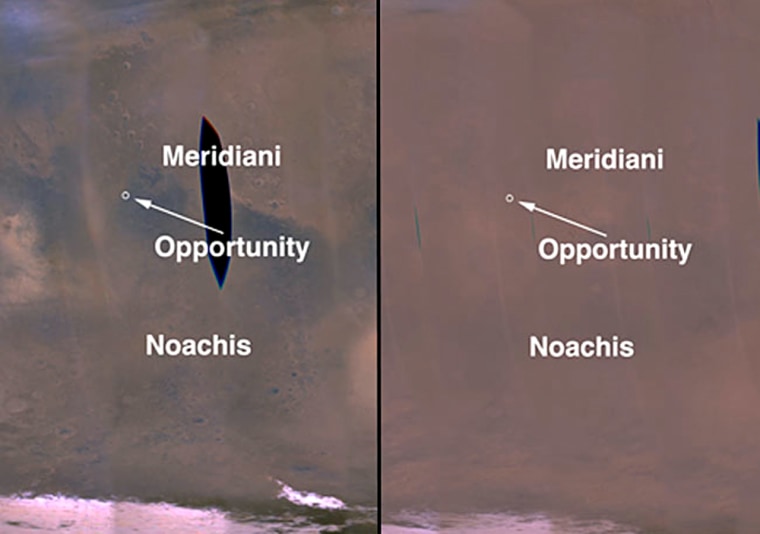A raging dust storm on Mars has cut power to NASA's twin rovers to dangerously low levels, threatening an end to the mission.
The rovers were slated to operate for only three months but have been on Mars more than three years, so mission officials have had ample time to ponder their silencing.
The storm presents perhaps the rover team's biggest challenge, NASA said in a statement Friday. Scientists said the storm, which has been brewing for nearly a month, is blocking around 85 to 90 percent of all sunlight to the surface.
The rovers, Opportunity and Spirit, rely on sunlight to charge their solar panels, and one or both rovers could be damaged permanently or even disabled by the limited solar power, officials said.
Space.com reported the storm's fresh severity earlier Friday.
Days or weeks to go
Scientists fear the storms might continue for several days or weeks. If the sunlight is further slashed for an extended period, the rovers will not be able to generate enough power to keep warm and operate at all, even in a near-dormant state, the statement said.
The rovers use electric heaters to keep vital core electronics from becoming too cold.
"We're rooting for our rovers to survive these storms, but they were never designed for conditions this intense," said Alan Stern, associate administrator of NASA's Science Mission Directorate.
"To give you a sense of the 'thickness' of the dust, the brightness of the sun as viewed from the surface is now down to less than 5 percent of what it would be with a perfectly transparent atmosphere," said Steve Squyres of Cornell University, who is the lead scientist of the Mars Exploration Rover project. "Of course, Mars never has a perfectly transparent atmosphere, but the sun is still very faint."
The rovers' scientific operations were stopped Wednesday.
"This is, I think, one of the most significant challenges we've faced over this entire mission," Squyres told Space.com. "The nature of the risk is well understood, but the magnitude of the risk is not. We simply don't know what's going to happen next."
Martian weather is unpredictable, in part because there are few monitoring instruments and no formal weather forecasting agency as on Earth.
"Whatever we do, though, the problem is not going to get much better rapidly," Squyres said. "I think that we have a good chance. If Mars really wants to kill these vehicles it can, but we have a lot of things working in our favor."
The cold, hard facts
If the rovers expend too much energy, they may be unable to warm their electronics and prevent circuit-snapping temperatures.
Before the dust storms began blocking sunlight last month, Opportunity's solar panels had been producing about 700 watt-hours of electricity per day, enough to light a 100-watt bulb for seven hours. When dust reduced the panels' daily output to less than 400 watt-hours, the rover team suspended driving and most observations, including use of the robotic arm, cameras and other site inspection instruments.
On Tuesday, the output from Opportunity's solar panels dropped to 148 watt-hours, the lowest point for either rover. On Wednesday, the output dropped even lower, to 128 watt-hours.
Mark Lemmon, a planetary scientist at Texas A&M University and member of the rover team, said Opportunity is consuming 130 watt-hours per Martian day in its "sleep mode." If the negative balance continues without a break, Lemmon explained, the rover may malfunction in a matter of weeks.
"Even with a 10 to 20 watt-hour gap, we'd have a healthy rover for over a week," Lemmon said in a telephone interview. "We've never been in situation where we've been in any imminent danger of a battery depleting, but it's possible."
NASA engineers are working to protect the rovers, especially Opportunity, which is experiencing the brunt of the dust storm. The rovers are showing robust survival characteristics. Spirit, in a location where the storm is currently less severe, has been instructed to conserve battery power by limiting its activities.
"We are taking more aggressive action with both rovers than we needed before," said John Callas, project manager for the twin rovers at NASA's Jet Propulsion Laboratory.
Hanging on
By Opportunity's 1,236th Martian day, which ended Tuesday, driving and all science observations had already been suspended. The rover still used more energy than its solar panels could generate on that day, drawing down its battery.
"The only thing left to cut were some of the communication sessions," Callas said.
To minimize further the amount of energy Opportunity is using, mission controllers sent commands on Wednesday, instructing the rover to refrain from communicating with Earth on Thursday and Friday. This is the first time either of the rovers has been told to skip communications for a day or more in order to conserve energy.
Slideshow 12 photos
Month in Space: January 2014
Since the onset of the storms, engineers have said a similar storm could be weathered by NASA's next Mars mission, a robotic lander. Human missions to Mars, a plan for the distant future, would be challenged greatly by storms like this, officials say.
Even if either of the rovers do malfunction, Lemmon explained all would not be lost.
"This is a really good scientific opportunity to understand how dust storms on Mars work, how they dissipate and how the dust moves around inside them," he said. "I think we'll be able to use the information we're getting now to look ahead to future mission to Mars."
Space.com's Robert Roy Britt contributed to this story.

